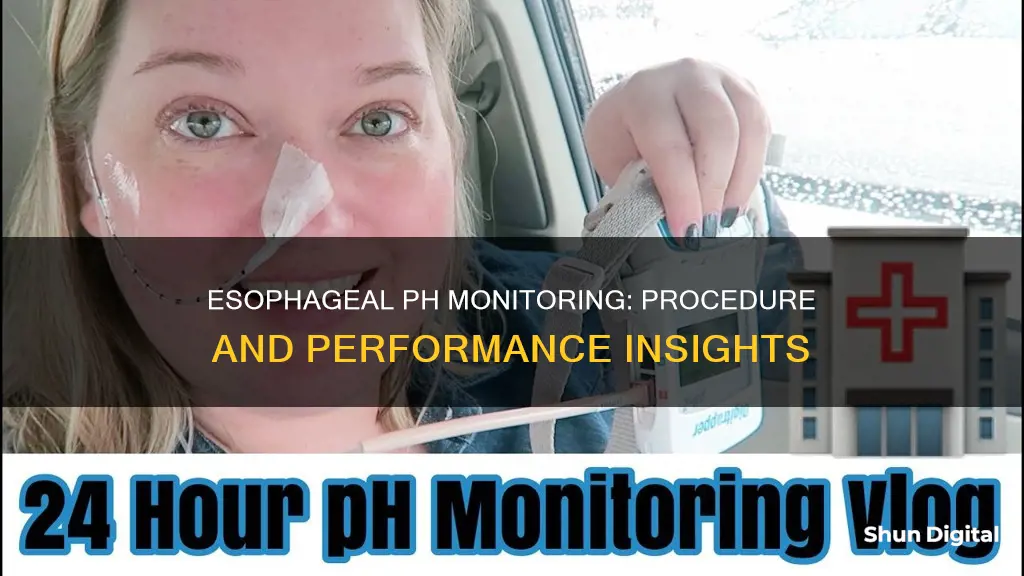
Oesophageal pH monitoring is a test that measures the frequency and duration of stomach acid entering the oesophagus. A thin tube is inserted through the nose or mouth and into the stomach, before being pulled back into the oesophagus. The tube is attached to a monitor that records the level of acidity in the oesophagus. The patient records symptoms and activities over the next 24 hours in a diary, which is then compared to the information from the monitor. This test is particularly useful for diagnosing gastroesophageal reflux disease (GERD) and checking how well acid is cleared into the stomach.
| Characteristics | Values |
|---|---|
| Purpose | To check how much stomach acid is entering the oesophagus and how well the acid is cleared downward into the stomach. It is a test for gastro-oesophageal reflux disease (GERD). |
| Test type | Wireless or catheter-based |
| Test duration | 24 hours, 48 hours, or 96 hours |
| Test preparation | Fasting for 4-6 hours, no eating or drinking after midnight before the test, no smoking, and potentially withholding certain medications |
| Test procedure | A thin tube is passed through the nose or mouth to the stomach, then pulled back into the oesophagus. A monitor attached to the tube measures the acid level (pH) in the oesophagus. |
| Patient actions during test | Wear the monitor on a strap, record symptoms and activities in a diary |
| Post-test procedure | Return to the hospital to have the tube removed, information from the monitor is compared with the diary notes |
What You'll Learn
- A thin tube is passed through the nose or mouth and positioned in the distal oesophagus
- The tube is connected to a battery-powered data collector worn on a strap
- The probe measures the acid level (pH) in the oesophagus
- The patient records symptoms and activities over 24 hours in a diary
- The information from the monitor is compared to the diary the patient provides

A thin tube is passed through the nose or mouth and positioned in the distal oesophagus
The tube is usually passed through the nose and positioned in the distal oesophagus, 5 cm above the upper border of the lower oesophageal sphincter (LES). The LES is a band of muscle that separates the oesophagus from the stomach and normally prevents stomach contents from flowing back up into the oesophagus. By placing the tube above the LES, the test can accurately measure the amount of acid entering the oesophagus. The tube is connected to a battery-powered data collector, which is usually worn with a shoulder strap. The patient can move around and perform regular activities during the test, and the position of the recording device can be altered to record acid reflux episodes in both upright and recumbent positions.
The patient will be instructed to fast for 4 to 6 hours before the procedure and will be provided with a diary to record the time of meals, the content of meals, the time of upright and recumbent periods, the time of administration of acid-suppressing medication, and the time of symptom occurrence. It is important to note that there are no clear guidelines on dietary restrictions, and patients are usually encouraged to continue their usual eating habits and engage in ordinary activities. However, they should avoid acidic foods and beverages such as citrus fruits, juices, soft drinks, clear tea, and pickled foods during the test.
The thin tube used for esophageal pH monitoring is typically 2.1 mm in diameter and can be passed through the nose or mouth. The transnasal approach is more common and involves passing the tube through the nostril and into the oesophagus. The patient may briefly feel like gagging as the tube is passed through the throat. Once the tube is in position, the patient can resume their normal activities, although they may experience some discomfort and altered eating and drinking habits due to the presence of the tube.
After the 24-hour monitoring period, the patient will return to the hospital, and the tube will be removed. The information from the monitor will be downloaded to a computer and analysed using specialised software. This data will be compared with the diary provided by the patient to correlate the symptoms and activities with the acid reflux episodes.
Esophageal pH monitoring is a safe procedure, but it may cause some discomfort and alter the patient's usual activities. It is important to counsel the patient on what to expect before the procedure and how to log their symptoms and activities in the diary. Some patients may not tolerate the transnasal catheter well, and there is a risk of equipment failure, probe migration, and poor intra-subject reproducibility with repeat studies.
In recent years, a newer technique called multichannel intraluminal impedance (MII) testing has been combined with pH testing to provide more detailed information about the refluxate, including its physical and chemical properties. The MII detects the movement of the bolus within the oesophagus by strategically placing a catheter. This combination of MII and pH testing can characterise the composition of the bolus, including whether it is liquid, gas, or a mixture of both, as well as its pH level.
Cleaning an LCD Monitor: Tips and Tricks
You may want to see also

The tube is connected to a battery-powered data collector worn on a strap
The tube is attached to a battery-powered data collector, which is usually worn with a shoulder strap. The data collector is worn by the patient for 24 hours, during which it records acid reflux episodes as occurring in either the upright or recumbent position. The patient can also record meals and symptoms by pushing event marker buttons on the data recorder. The data collector is then returned to the provider, and the information is downloaded to a computer for analysis.
The wireless pH monitoring system, such as the Bravo pH monitor, is more expensive than the traditional method but improves patient comfort. The Bravo capsule is attached to the esophageal mucosa with a delivery system that drives a small needle into the epithelium. The capsule then transmits pH data to a portable receiver using radiofrequency signals. The Bravo system is better tolerated by patients, but cost considerations may limit its utilization.
Eliminating Monitor Glare That Affects Glasses: Practical Tips
You may want to see also

The probe measures the acid level (pH) in the oesophagus
The probe measures the pH level in the oesophagus, which is normally between 5 and 7. A pH level below 4 indicates acid reflux. The percentage of time that the pH is below 4 is the most reproducible measure of a pathological degree of acid reflux. The probe also measures the duration of the longest reflux episode and the number of episodes greater than five minutes. The probe can be left in place for 24, 48 or 96 hours.
The probe is usually placed by passing a thin, flexible tube (catheter) through the nose and into the oesophagus. The tube has a sensor that measures the acid level. The other end of the tube is connected to a small monitor that the patient wears around the waist or over the shoulder. The patient will also keep a diary of their symptoms and the food they eat during the monitoring period.
A newer technique is the Bravo wireless pH monitoring system, which improves patient comfort but is more expensive. The Bravo system uses a wireless pH capsule that is placed endoscopically, 6 cm above the squamocolumnar junction. The capsule transmits pH data to a receiver worn around the waist or on a belt. The patient will also keep a diary of their symptoms and the food they eat during the monitoring period.
LCD Monitor Projector: Understanding the Technology Behind It
You may want to see also

The patient records symptoms and activities over 24 hours in a diary
The patient will be asked to record their symptoms and activities over 24 hours in a diary. They will be instructed to fast for 4 to 6 hours before the insertion of the probe. They will be provided with a diary to record the time of meals, the content of meals, the time of upright and recumbent periods, the time of administration of acid-suppressing medication, and the time of symptom occurrence. Patients are encouraged to continue their usual eating habits and engage in ordinary activities that are known to induce symptoms. There are no clear guidelines on dietary restrictions, and these vary from provider to provider.
Monitoring TempDB Usage: A Guide for SQL Server Admins
You may want to see also

The information from the monitor is compared to the diary the patient provides
The patient is encouraged to continue their usual eating habits and engage in ordinary activities that are known to induce symptoms. The patient's diary is used to corroborate the timings of events and is returned to the provider along with the recording unit at the end of the study. The information from the monitor is then downloaded to a computer, and subsequent data analysis follows using a software system.
Hooking Up Multiple Monitors: USB Desktop Connection Guide
You may want to see also
Frequently asked questions
The procedure typically takes 24 hours. However, there are also 48- and 96-hour options available.
A thin tube is passed through the nose or mouth to the stomach and then pulled back into the oesophagus. The tube is attached to a monitor that records the acid level in the oesophagus. The patient wears the monitor on a strap and records their symptoms and activities in a diary over the next 24 hours.
The test helps to determine the amount of stomach acid entering the oesophagus and how well the acid is cleared downward into the stomach. It is used to check for gastroesophageal reflux disease (GERD) and other problems related to excessive crying in infants.







